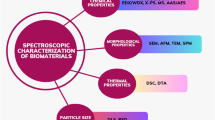Abstract
Latex versus glass has frequently been used as a model system for the investigation of natural lubrication mechanisms, despite its significant differences from articular cartilage pairings. The differences in surface chemistry account for its different behavior in terms of protein adsorption and lubrication. While cartilage is well known for its protein resistance, most proteins present in synovial fluid can non-specifically adsorb onto latex or glass. We have investigated latex-versus-glass lubrication by means of pin-on-disk tribometry in the presence of synovial-fluid proteins and glycoproteins, focusing on the influence of the glass-cleaning procedure on friction. In order to simulate the effects of possible contamination of glass in previous studies, both hydrophilic and hydrophobic glass substrates were tested. Albumin was shown to impair lubrication (in comparison to PBS) when latex was slid against both types of glass surface, whereas bovine synovial fluid (BSF) and alpha-1-acid glycoprotein (AGP) impaired the lubrication of latex versus hydrophilic glass and improved the lubrication of latex versus hydrophobic glass. Protein adsorption on the surfaces was monitored by means of fluorescence imaging and optical waveguide lightmode spectroscopy (OWLS), which revealed a faster and greater amount of adsorption of AGP on hydrophobic surfaces than on hydrophilic ones. The influence of surface chemistry on the friction behavior of BSF and on the adsorption of AGP suggests that it plays a role in determining the relative amounts of adsorbed synovial fluid proteins. When BSF is used as a lubricant in the latex-versus-hydrophobic-glass system, more of the AGP, relative to albumin, appears to adsorb on both surfaces, counteracting the negative effect of albumin on friction. It therefore seems that latex on glass, while displaying nominal similarities to cartilage on cartilage under certain conditions, is not a useful model system. Moreover, surface contamination of the glass can play a major role in determining the results.






Similar content being viewed by others
References
Prete, P.E., Gurakar-Osborne, A., Kashyap, M.L.: Synovial fluid lipids and apolipoproteins: a contemporary perspective. Biorheology 32(1), 1–16 (1995)
Foster, H., Fisher, J.: The influence of loading time and lubricant on the friction of articular cartilage. Proc. Inst. Mech. Eng. G 210, 109–119 (1996)
Roberts, B.J., Unsworth, A., Mian, N.: Modes of lubrication in human hip joints. Ann. Rheum. Dis. 41, 217–224 (1982)
Crockett, R.: Boundary lubrication in natural articular joints. Tribol. Lett. 35(2), 77–84 (2009)
Jay, G.D., Tantravahi, U., Britt, D.E., Barrach, H.J., Cha, C.-J.: Homology of lubricin and superficial zone protein (SZP): products of megakaryocyte stimulating factor (MSF) gene expression by human synovial fibroblasts and articular chondrocytes localized to chromosome 1q25. J. Orthop. Res. 19(4), 677–687 (2001)
Swann, D.A., Hendren, R.B., Radin, E.L., Sotman, S.L., Duda, E.A.: The lubricating activity of synovial fluid glycoproteins. Arthritis Rheum. 24(1), 22–30 (1981)
Swann, D.A., Radin, E.L.: The molecular basis of articular joint lubrication. 1. Purification and properties of a lubricating fraction from bovine synovial fluid. J. Biol. Chem. 247(24), 8069–8073 (1972)
Radin, E.L., Swann, D.A., Weisser, P.A.: Separation of a hyaluronate-free lubricating fraction from synovial fluid. Nature 228(5269), 377–378 (1970)
Crockett, R., Grubelnik, A., Roos, S., Dora, C., Born, W., Troxler, H.: Biochemical composition of the superficial layer of articular cartilage. J. Biomed. Mater. Res. A 82A(4), 958–964 (2007)
Crockett, R., Roos, S., Rossbach, P., Dora, C., Born, W., Troxler, H.: Imaging of the surface of human and bovine articular cartilage with ESEM and AFM. Tribol. Lett. 19(4), 311–317 (2005)
Davis Jr., W.H., Lee, S.L., Sokoloff, L.: Boundary lubricating ability of synovial fluid in degenerative joint disease. Arthritis Rheum. 21(7), 754–760 (1978)
Jay, G.D.: Characterization of a bovine synovial fluid lubricating factor. 1. Chemical, surface activity and lubricating properties. Connect. Tissue Res. 28, 71–88 (1992)
Jay, G.D., Britt, D.E., Cha, C.J.: Lubricin is a product of megakaryocyte stimulating factor gene expression by human synovial fibroblasts. J. Rheumatol. 27, 594–600 (2000)
Jay, G.D., Haberstroh, K., Cha, C.J.: Comparison of the boundary-lubricating ability of bovine synovial fluid, lubricin, and Healon. J. Biomed. Mater. Res. 40(3), 414–418 (1998)
Chang, D.P., Abu-Lail, N.I., Guilak, F., Jay, G.D., Zauscher, S.: Conformational mechanics, adsorption, and normal force interactions of lubricin and hyaluronic acid on model surfaces. Langmuir 24(4), 1183–1193 (2008)
Zappone, B., Ruths, M., Greene, G.W., Jay, G.D., Israelachvili, J.N.: Adsorption, lubrication and wear of lubricin on model surfaces: polymer brush-like behavior of a glycoprotein. Biophys. J. 92, 1693–1708 (2007)
Raviv, U., Giasson, S., Kampf, N., Gohy, J.-F., Jerome, R., Klein, J.: Lubrication by charged polymers. Nature 425(6954), 163–165 (2003)
Roba, M., Naka, M., Gautier, E., Spencer, N.D., Crockett, R.: The adsorption and lubrication behavior of synovial fluid proteins and glycoproteins on the bearing-surface materials of hip replacements. Biomaterials 30(11), 2072–2078 (2009)
Heuberger, M.P., Widmer, M.R., Zobeley, E., Glockshuber, R., Spencer, N.D.: Protein-mediated boundary lubrication in arthroplasty. Biomaterials 26(10), 1165–1173 (2005)
Author information
Authors and Affiliations
Corresponding author
Rights and permissions
About this article
Cite this article
Roba, M., Bruhin, C., Ebneter, U. et al. Latex on Glass: an Appropriate Model for Cartilage-Lubrication Studies?. Tribol Lett 38, 267–273 (2010). https://doi.org/10.1007/s11249-010-9603-7
Received:
Accepted:
Published:
Issue Date:
DOI: https://doi.org/10.1007/s11249-010-9603-7




